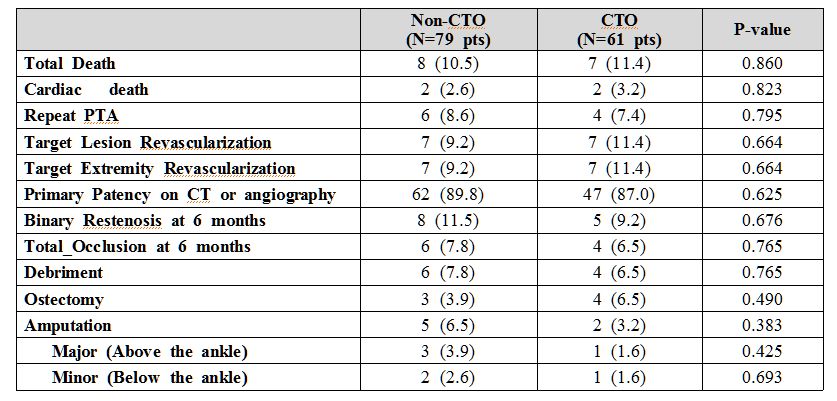| ЙпЧЅЧќНФ : ЦїНКХЭБИПЌ
|
СЂМіЙјШЃ - 550103 39 |
| Impact of Chronic Total Occlusion in Ilio-femoral Artery on Clinical Outcomes following Percutaneous Transluminal Angioplasty |
| ъГ ы ЄыэъЕ ъЕЌыЁыГь ьЌэъДьМэА |
| ыьЙьД, ьЕыГъБИ, Amro Elnagar, ььБьМ, ъЙь ь, ыьЇьЄ, эьБьА, ьЕьВ ь
, ьэь, ъЙьЇь, ъЙььЃМ, ыАьАНъЗ, ьэь, ьЄыьЃМ |
Background: Endovascular treatment (EVT) is considered as an effective treatment in patients (pts) with critical limb ischemia (CLI). With the recent improvement of device and EVT technique, the success rate of chronic total occlusion (CTO) in ilio-femoral artery is very high; however, the mid to long-term durability following successful recanalization is not clarified yet.
Methods: This study consisted of 187 consecutive CLI pts underwent percutaneous transluminal angioplasty (PTA) from May 2005 to September 2010. Among these pts, 140 (74.8%) CLI pts presented with significant ilio-femoral artery lesion (181 Limb, 91 lesions) and 61 pts had CTO (82 Limb, 91 lesions). CTO recanalization was done either by true lumen angioplasty (shorter lesion) or subintimal angioplasty (longer lesion) with/without reentry device. Provisional stenting was done once the balloon angioplasty outcome is not optimal, mainly by self-expanding nitinol stents. Periprocedural complications and major clinical outcomes of CTO group (n=82 pts) were compared with those of non-CTO group (n=79 pts) up to 12 months.
Results: The baseline clinical characteristics were similar between the two groups except that previous cerebrovascular accident (3.7% vs. 1.6%, p<0.001), chronic kidney disease (5.0% vs. 3.2%, <0.001), and current alcoholics (32.9% vs. 21.3%, p<0.001) were more in the non-CTO group. Mid-term primary patency was approaching 90% and angiographic outcomes were similar between the two groups. Major clinical outcomes including mortality, repeat revascularization and the incidence of surgical intervention were similar between the two groups (Table).
Conclusion: Once the CTO lesions were successfully treated, major mid-term angiographic and clinical outcomes were similar with those of non-CTO lesions. Long-term follow up with larger study population will be needed to get the final conclusion.
|
|
Table. Six-month Clinical Outcomes
|
Warning: getimagesize(/home/virtual/circulationadmin/renewal/econgress/conference/abstract/img_files/PTA-ATK-CTo.jpg) [function.getimagesize]: failed to open stream: No such file or directory in /home/virtual/circulationadmin/new/econgress/conference/manage/schedule/view_abstract.php on line 164

|
|





